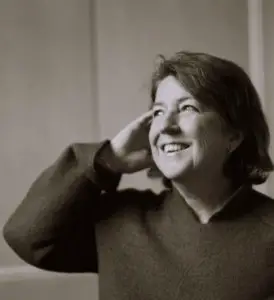A Guest Post by Kim Allen-Niesen, co-founder of Bookstore People
For information on becoming a contributor click here..

image courtesy of Cato Lein
The more you know about a book, the easier it is to hand sell it. At the invitation of Literary Affairs , I was able to attend a breakfast interview with Linda Olsson about her latest book, Sonata for Miriam. What I enjoy most about Linda’s writing is her uncanny ability to portray a sense of place. I felt that the landscape was almost a separate character in her first book, Astrid & Veronica, and should be part of any reading list trying to highlight that particular attribute of writing. Sonata for Miriam occurs in three locations, all of which are strongly portrayed in the book. The primary theme of Sonata for Miriam is the search for family and home when you need to create it. We see that in Adam, Cecilia and Moishe as they each try to reconcile their history and how to be at peace in their present.
Linda is very open about the writing process and the development of the book. Here are some of the highlights of the conversation (mild spoiler alert and this isn’t a review but background information to help sell the book):
Music Theme
- The structure of the book is a sonata. The two themes, Adam’s recent past and his family history, combine to leave Adam in a new place securely rooted in his past. It’s a formula that should be held loosely though since the American edition didn’t keep the same numbering. Moreover, the reader who doesn’t know musical form won’t miss a beat, but the one who does will have fun matching the two arts. Linda wrote the book without fitting it into a sonata form. She then realized how the musical formula and title fit Adam’s character, so she asked musicians to read it and give comments. She found she just needed to tighten up a few parts for a closer fit to the sonata form.
- The opening quote is from the overture to Music of Another World by Szymon Laks, an actual piece of music. Szymon Laks survived the concentration camps because he played in the camp orchestra. Linda wanted the music played at the book launch party, but couldn’t find it anywhere, not on a CD, not in sheet music, not on the Internet. Finally, she remembered hearing it at the US Holocaust Museum and called their archives. The staff was terrific; they located the music and sent it to her. The world premiere of Music for Another World was at the launch party.
- Music is used as a connection throughout the book: Moishe plays it in his study; Cecilia wakes up to music; it is what ties the previous generation of teenagers together; and, the sonata is Adam’s tribute to Mimi. Linda feels that one of music’s magical qualities is that it connects people from different cultures and languages.
Holocaust Aspects
- Moishe’s apartment and Clara’s life story give a sense of the community in Krakow before the Holocaust. Linda visited a survivor in Poland and they spoke for several hours. As Linda was leaving, the survivor thanked her for asking what her life was like before the Nazis, she said no one asked her that anymore.
- A scene in the book is picked up from a visit to a survivor in Wellington, the woman had a silver box similar to one Linda owned and said “I just keep old photographs in there.”
Writing Process
- Linda believes a reason for the sparseness of her language is her Swedish roots, since Swedes tend to use precise words. On the other hand, if she was writing in her native language, she might use more words due to familiarity with the language. Because English is her second language, she is more particular and chooses her words carefully. She did not translate her books into Swedish; each book has a separate translator.
- Linda described Adam as someone who walked into her life one day and showed himself to her. She knew how he looked, but only discovered his character over time. She doesn’t believe that she chose some of the plot elements, but that they are part of Adam’s story that he revealed to her. Her first visit to Krakow was unique because it was Adam’s first visit also; she experienced the city through her eyes and his at the same time. She feels very humbled by the entire Adam experience and initially wondered if she could or should write his story.
- Linda is a visual person who sees her books in pictures first. She feels that she is watching a film and writing the script.
Hopefully, these revealing and fun insights into the book will make it easier to sell during the upcoming summer season.


Well. Ah. Nobody has ever written anything this beautiful about my books or my writing. It is embarrassing. Impossible to take in. Yet so … very accurate. Thank you